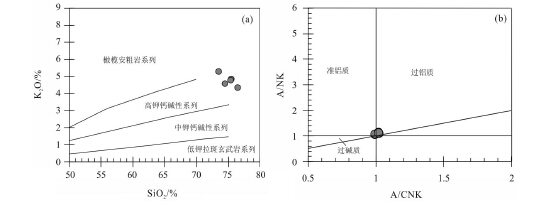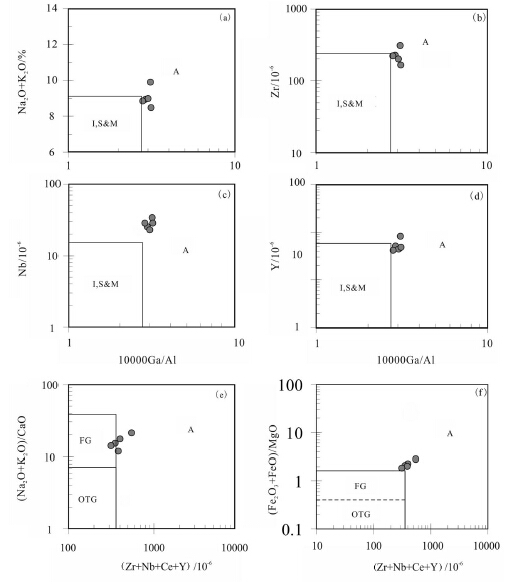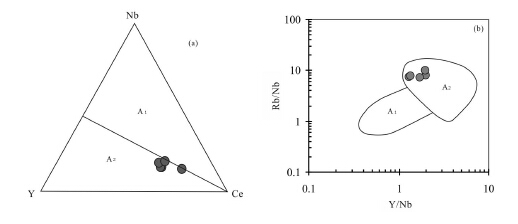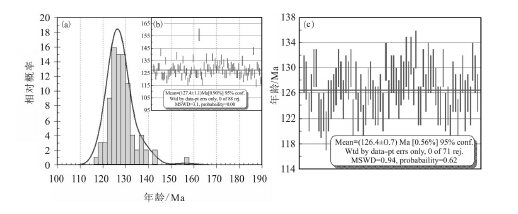The discovery of the syenogranite with an age of 126 Ma in the depth of Tongling: Evidence from 3000 meters scientific drilling
-
摘要:
铜陵矿集区3000 m科学钻揭示,舒家店地区在1775 m以下存在红色的正长花岗岩,从该深度继续钻进约700 m后仍为这种岩石,而这种岩石在地表或其他钻孔中从未见到过。研究表明,正长花岗岩以富硅、富碱,富含高场强元素如Zr、Nb、Y和轻稀土元素(Eu除外)和较低的MgO、Ba和Sr的含量为特征,全岩的10000 Ga/Al比值为>2.6,Zr+Nb+Ce+Y>350×10-6,稀土元素配分模型具有明显的Eu负异常,微量元素原始地幔标准化曲线具有明显的Ba、Sr、P、Ti亏损,表现出A型花岗岩的地球化学属性。锆石LA-MC-ICP-MS U-Pb定年结果表明,该A型花岗岩的年龄为126 Ma,与长江中下游地区其他A型花岗岩的时代一致,属于长江中下游地区三期岩浆活动当中的第二期岩浆活动的产物。研究表明,长江中下游地区3次岩浆作用与岩石圈的多次拆沉作用密切相关,而且每一次拆沉作用都会使壳幔附近的深位岩浆房向地壳浅部迁移,而A型花岗岩则是迁移到浅部的深位岩浆房诱发的地壳部分熔融形成的岩浆,沿断裂带侵位而形成,也标志着本区的构造背景在126 Ma时处于拉张的高峰期。
Abstract:Tongling Scientific Drilling revealed that there exists a red syenogranite at 1775 meters below the surface in Shujiadian,Tongling,which has never been seen at the surface or in other drill holes of Tongling area before,and drilling about 700 meters still intersects the rock. Studies show that the syenogranite is characterized by higher content of SiO2 and Na2O+K2O, and lower content of MgO, Ba and Sr, enrichment of HFSE (high field strength element) such as Zr, Nb, Y and LREE (light rare earth element) except Eu. The rock has a ratio of 10000Ga/Al>2.6,the total Zr+Nb+Ce+Y>350×10-6, obvious Eu negative anomaly in the chondritenormalized REE patterns and depletion of Ba, Sr, P and Ti in the primitive mantle-normalized trace element diagram, showing Atype granite property. Zircon LA-MC-ICP-MS dating yielded a U-Pb age of 126 Ma for the A-type granite, which is consistent with the age of the other A-type granites in the middle and lower reaches of the Yangtze River (MLRYR), and belongs to the product of the second episode in the three episodes of the magmatism in the area. Researches indicate that the three episodes of magmatism in the MLRYR region had a closed relation to the multiple lithosphere delamination. With the continuing delamination, the deep magma chamber near the crust-mantle migrated to the shallow part, causing partial melting of the crust to form A-type granite when the magma was emplaced along the deep fault. It also marked a peak pull-apart in the tectonic background of the MLRYR region.
-
Keywords:
- zircon U-Pb dating /
- A-type granite /
- Shuijiadie in Tongling
-
阿尔金造山带位于青藏高原的北部边缘,是塔里木地块和柴达木地块的天然分界线。由于其特殊的构造位置,一些重要的构造线(如蛇绿岩带和高压—超高压变质带)都在此突然消失或者转变了方向。它是一个经历了多期复杂的构造演化,由不同的构造层次和形成于不同构造环境地质体组成的复合构造带,因此一直成为中外学者关注的焦点[1-2]。前人对其大地构造属性存在不同的认识:张显庭等认为是早古生代造山带[3]。葛肖虹等则提出为肢解的“西域板块”,是板块在晚白垩世—始新世相互作用的结果[4]。整个地区长期以来被认为是塔里木地块的组成部分[5-6]。随着地区研究程度的加深,前人对阿尔金地区构造单元的划分提出了新的方案,如校培喜等认为阿尔金山构造带由两带两块组成, 自北向南分别为阿北地块、红柳沟—拉配泉蛇绿构造混杂岩带、阿中地块、清水泉—茫崖蛇绿构造混杂岩带[7]。有些学者通过研究构造带内不同地质体的地质特征以及岩石学、地球化学和同位素等资料,将构造带划分为阿北变质地体、红柳沟—拉配泉构造混杂岩带、阿中米兰河—金雁山地块、阿南茫崖蛇绿构造混杂岩带四个构造单元[8], 刘永顺等根据不同的岩石组合和构造特征将阿尔金地区划分为敦煌地块、阿北蛇绿混杂岩带、阿尔金中—新元古代构造岩片、阿尔金构造杂岩带和阿南基性超基性岩带5个构造单元[9]。
近几年来,南阿尔金地区的研究主要集中在阿尔金高压—超高压变质带以及蛇绿混杂岩带,取得了显著的成果[10-14]。相对于北阿尔金地区,南阿尔金地区的研究程度相对较低,仅仅局限于研究区的高压超高压变质带。前人在南阿尔金超高压变质锆石微区LA-ICP-MS定年获得核部年龄为(754±9)Ma,并认为其原岩具有洋壳性质[15],表明南阿尔金以及柴北缘地区可能在800~750 Ma已经出现了洋壳, 本地区在青白口纪晚期就出现了初始的裂谷或者是洋盆,那么研究区Rodinia超大陆最早初始裂解发生在何时呢?笔者研究了阿尔金南部帕夏拉依档沟一带斜长角闪岩的岩石学、年代学以及地球化学特征,认为其可能为Rodinia超大陆初始裂解事件在阿尔金南缘的响应,为阿尔金造山带新元古代的构造演化提供了新的证据。
1. 区域地质背景及岩石学特征
1.1 区域地质背景
研究区大地构造位置位于阿尔金造山带,以阿尔金南缘主断裂为界,进一步划分为阿中地块和阿南蛇绿构造混杂岩带2个二级构造单元❶。阿中地块出露地层主要为古元古界阿尔金岩群和青白口系索尔库里群,其中阿尔金岩群为基底变质岩系,原岩可能为一套浅海相碎屑岩-火山岩-碳酸盐岩建造,索尔库里群变质程度较低,为陆块边缘裂陷海盆碎屑岩-火山岩-碳酸盐岩建造。根据1:25万苏吾什杰幅区域地质调查报告成果❶,阿南蛇绿构造混杂岩带主要由奥陶纪蛇绿岩、蛇绿岩上覆岩系、外来岩片等构造块体和变形基质两部分组成,块体有蛇纹石化橄榄岩、辉长岩、玄武岩、硅质岩、黑云斜长片麻岩、白云质大理岩、变砂岩及含砾砂岩等,基质主要由构造片岩、劈理化细砂岩、板岩、凝灰岩等组成。同时研究区位于多个构造带交汇部位,岩浆活动较为频繁,主要有中新元古代变质侵入岩盖里克片麻岩和亚干布阳片麻岩,古生代基性-酸性侵入岩帕夏拉依档岩体和玉苏普阿勒克塔格岩体。中―新生代沉积盆地上叠于阿中地块和阿南蛇绿构造混杂岩带之上,其自下向上可分为中生代侏罗纪、新生代新近纪和第四纪3个时期不同类型的沉积建造,沉积地层分别为侏罗系大煤沟组、新近系油砂山组和第四系沉积物。
❶王永和, 校培喜, 潘长利, 等.新疆1:25万苏吾什杰幅区域地质调查报告[R].西安:西安地质矿产研究所. 2003.
![]() 图 1 研究区地质简图及采样位置TRB—塔里木盆地; QL—祁连山; QDB—柴达木盆地; WKL—西昆仑; EKL—东昆仑; TIBET—西藏; HMLY—喜马拉雅山; INP—印度板块; Ⅰ—阿北变质地块; Ⅱ—红柳沟-拉配泉混杂岩带; Ⅲ—米兰河-金雁山地块; Ⅳ—阿尔金南缘俯冲碰撞杂岩带; 1—第四系; 2—新近系油砂山组; 3—侏罗系大煤沟组;4—奥陶纪茫崖蛇绿混杂岩; 5—青白口系索尔库里群; 6—古元古代阿尔金岩群; 7—玉苏普阿勒塔格岩体;8—帕夏拉依档岩体;9—亚干布阳片麻岩;10—盖里克片麻岩;11—超基性岩块体; 12—玄武岩块体; 13—辉长岩脉;14—斜长角闪岩;15—区域大断裂;16—韧性剪切带;17—断层;18—不整合界限; 19—采样位置Figure 1. Simplified geological map of the study area and sampling sitesTRB-Tarim basin; QL-Qilian Mountains; QDB-Qaidam basin; WKL-West Kunlun; EKL-East Kunlun; TIBET-Tibet; INP-Indian plate; HMLY-The Himalayas; INP-Indian plate; Ⅰ-Metamorphism plot of northern Altyn; Ⅱ-Hongliugou-Lapeiquan melange; Ⅲ-Milanhe-Jinyanshan plot; Ⅳ-Subduction collision complex zone of southern Altyn; 1-Quaternary; 2-Youshashan Formation; 3-Dameigou Group; 4-Mangya ophiolite melange; 5-Suoerkuliqun Group; 6-Aerjin Group; 7-Yusupualetage rock body; 8-Paxialayidang rock body; 9-Yaganbuyang gneiss; 10-Gailike gneiss; 11-Ultrabasic block; 12-Basalt block; 13-Gabbro dyke; 14-Amphibolite; 15-Regional fault; 16-Ductile shear zone; 17-Fault; 18-Unconformity; 19-Sampling location
图 1 研究区地质简图及采样位置TRB—塔里木盆地; QL—祁连山; QDB—柴达木盆地; WKL—西昆仑; EKL—东昆仑; TIBET—西藏; HMLY—喜马拉雅山; INP—印度板块; Ⅰ—阿北变质地块; Ⅱ—红柳沟-拉配泉混杂岩带; Ⅲ—米兰河-金雁山地块; Ⅳ—阿尔金南缘俯冲碰撞杂岩带; 1—第四系; 2—新近系油砂山组; 3—侏罗系大煤沟组;4—奥陶纪茫崖蛇绿混杂岩; 5—青白口系索尔库里群; 6—古元古代阿尔金岩群; 7—玉苏普阿勒塔格岩体;8—帕夏拉依档岩体;9—亚干布阳片麻岩;10—盖里克片麻岩;11—超基性岩块体; 12—玄武岩块体; 13—辉长岩脉;14—斜长角闪岩;15—区域大断裂;16—韧性剪切带;17—断层;18—不整合界限; 19—采样位置Figure 1. Simplified geological map of the study area and sampling sitesTRB-Tarim basin; QL-Qilian Mountains; QDB-Qaidam basin; WKL-West Kunlun; EKL-East Kunlun; TIBET-Tibet; INP-Indian plate; HMLY-The Himalayas; INP-Indian plate; Ⅰ-Metamorphism plot of northern Altyn; Ⅱ-Hongliugou-Lapeiquan melange; Ⅲ-Milanhe-Jinyanshan plot; Ⅳ-Subduction collision complex zone of southern Altyn; 1-Quaternary; 2-Youshashan Formation; 3-Dameigou Group; 4-Mangya ophiolite melange; 5-Suoerkuliqun Group; 6-Aerjin Group; 7-Yusupualetage rock body; 8-Paxialayidang rock body; 9-Yaganbuyang gneiss; 10-Gailike gneiss; 11-Ultrabasic block; 12-Basalt block; 13-Gabbro dyke; 14-Amphibolite; 15-Regional fault; 16-Ductile shear zone; 17-Fault; 18-Unconformity; 19-Sampling location帕夏拉依档一带出露地层主要为阿尔金岩群,1:25万苏吾什杰幅区调❶在其中填绘了“帕夏拉依档上游变质岩片”,虽然没有在其中发现高压变质岩或高压变质的信息,但认为其具有类似的构造环境和相似的围岩性质。在《阿尔金地区1:5万J45E010020、J45E010021、J45E010022、J45E011020、J45E011021、J45E011022六幅区域地质矿产调查》项目的野外地质调查过程中,笔者对该岩片进行了详细的调查和研究,发现该岩片呈一长透镜体状近东西向分布。长约15 km,最宽处约2.5 km,面积约30 km2,岩片夹裹于阿尔金岩群的片麻岩中,四周以韧性断裂带与围岩接触,该岩片由基质岩石和构造透镜体组成形成“包含”结构,基质岩石主要为碳酸盐岩,而构造透镜体则全为斜长角闪岩,未发现超高压榴辉岩的存在,初步认为该岩片也是阿尔金岩群的组成部分,呈构造透镜体分布的斜长角闪岩为残留的基性岩墙,本文主要对这套斜长角闪岩开展岩石学、年代学以及地球化学方面的研究。
1.2 岩石学特征
本文样品采自阿尔金南部帕夏拉依档沟一带,大都呈透镜状或豆荚状产出于阿尔金岩群的大理岩中(图 2-a、2-b)。露头一般,表面为灰黑—灰绿色, 单个规模不大并且较为分散,大小为3 m×1.5 m~5 m×2 m, 其透镜体长轴方向与区域上片麻理方向平行或者呈小角度斜交。由于后期构造运动的改造,局部可见透镜体被节理或小型的断层所切割。其围岩为大理岩,风化面为黄褐色,新鲜面为白色,具有粒状变晶结构(粒径为0.5~1.5 mm),块状构造,局部可见大理岩呈岩块状产出。
![]() 图 2 斜长角闪岩野外及镜下特征a、b—样品呈透镜状或豆荚状产出;c—单偏镜下斜长角闪岩;d—正交镜下斜长角闪岩Q—石英;Am—角闪石;Ep—绿帘石;Ch—绿泥石;Bi—黑云母Figure 2. Photos of the outcrops and microscopic identificationa, b-Amphibolite in lenticular or podiform form in the open pit; c-Amphibolite (plainlight); d-Amphibolite (crossed nicols) Q-Quartz; Am-Amphibole; Ep-Epidote; Ch-Chlorite; Bi-Biotite
图 2 斜长角闪岩野外及镜下特征a、b—样品呈透镜状或豆荚状产出;c—单偏镜下斜长角闪岩;d—正交镜下斜长角闪岩Q—石英;Am—角闪石;Ep—绿帘石;Ch—绿泥石;Bi—黑云母Figure 2. Photos of the outcrops and microscopic identificationa, b-Amphibolite in lenticular or podiform form in the open pit; c-Amphibolite (plainlight); d-Amphibolite (crossed nicols) Q-Quartz; Am-Amphibole; Ep-Epidote; Ch-Chlorite; Bi-Biotite斜长角闪岩呈灰绿色,镜下显示为柱状粒状变晶结构,块状构造(图 2-c、2-d)。主要矿物为角闪石(45%~65%)、斜长石(20%~35%)、石英(5%~15%)、黑云母(5%~10%),还有少量的绿泥石、绿帘石、铁质等,副矿物为锆石、磷灰石、磁铁矿等。其中角闪石粒度大小为0.23~1.11 mm,浅绿色、黄绿色,半自形柱状,晶体比较破碎,晶形不完整,具闪石式解理,次生绿泥石化、绿帘石化较强,析出铁质,弱定向排列,集晶形成条带。斜长石粒度大小为0.20~0.56 mm,呈半自形板条状、他形粒状,双晶不清楚,晶面比较浑浊,次生泥化、绢云母化、硅化较强,杂乱分布。岩石经历了变形,可见角闪石、斜长石和石英出现微弱的定向排列,据镜下观察和分析认为它们应属于同一个矿物共生组合,其变质程度相当于中温中压的角闪岩相,原岩可能为基性辉长岩。
2. 样品分析方法
样品采集过程中,为保证样品的质量将其外侧刨去,选取新鲜、纯净无脉体的岩石,并对其进行相关的分析测试和研究。
2.1 年代学分析方法
年龄样品用常规的磁选和重选技术得到锆石,在双目镜下挑选出无包裹体、无裂纹、透明度及晶型较好的锆石用于测年。将挑选出来的锆石颗粒黏在双面胶上,用无色透明的环氧树脂固定,然后对其表面进行抛光至锆石内部暴露。锆石反射光、透射光、阴极发光照相在西北大学扫描电镜加载阴极发光仪上完成。锆石U-Pb定年是在西北大学大陆动力学国家重点实验室完成,定年仪器为ShieldTorch Agilient7500a型LA-ICP-MS;激光剥蚀系统为德国MicroLas公司生产的GeoLas200M,激光器为Lambda Physik公司的ComPex102 ArF(工作物质ArF,波长为193 nm);实验室采用He作为剥蚀物质的载气,束斑直径为30μm,剥蚀深度为20~40μm,频率为10 Hz;方式为单点剥蚀,每个分析点的气体背景采集时间为30 s,信号采集时间为40 s;用美国国家标准人工合成硅酸盐玻璃标准参考物质NISTSRM 610进行仪器最佳化调试,数据采集选用质量峰采点的跳峰方式,每完成5个待测样品测定,插入测标样一次。年龄计算以国际标准锆石91500作为外部物质,元素含量采用NIST SRM610作为外标,由于SiO2在锆石中较为稳定,采用29Si作为内标。数据处理采用GLITTER(ver4.0, MacquarieUniversity)程序, 采用Isoplot3.0程序[16]计算加权平均年龄并绘制谐和图,所获得同位素比值和年龄误差都在1σ之内。详细的实验原理和过程以及所使用的仪器可参见文献袁洪林等[17]。
2.2 主量、微量元素分析方法
所采集地球化学样品均在咸阳核工业203研究所分析测试中心分析完成。主量元素采用荷兰帕纳科制造的AxiosX射线光谱仪分析,分析精度(相对标准差)一般小于1%;稀土元素用电感耦合等离子体质谱法(XSERIES2型ICP-MS)分析,微量元素用电感耦合等离子体发射光谱法(ICP-AES)分析,两者的分析精度都优于5%。
3. 锆石U-Pb年代学特征
本文对样品进行了LA-ICP-MS锆石U-Pb年代测定,共测了20个点。从锆石形态和阴极发光图像上来看(图 3-b),锆石粒度和形态差别较大,多为不规则状,少量锆石可见后期形成的白色退变亮边,大部分呈灰-深灰色,可能与锆石中U、Th、REE等微量元素含量较多有关[18]。锆石总体上可以分为2种类型。一种是岩浆锆石,呈短柱状—半浑圆状,粒径从60~150μm不等,长宽之比为3:1,可见明显的岩浆震荡环带,推测较宽的环带生长过程中由于较高的温度促使微量元素快速迁移所致。Th=58×10-6~579×10−6,U=121×10-61961×10-6,Th/U大部分比值介于0.40~0.67,暗示其为岩浆成因[19]。另一种为变质锆石,半浑圆-浑圆状状,可见明显的核边结构和扇形环带结构,少量呈阴暗明显的斑杂状,可能是由于锆石在变质重结晶过程中固态结晶速率不同造成的。第二类锆石U、Th含量与第一类锆石相比均较高,分别集中在U=298×10-6640×10-6,Th=123×10-6229×10-6,其Th/U比值平均为0.46,比值与传统变质锆石有所差异[20]。U-Pb年代学测试结果如表 1和图 3-a所示,可以看出所有的测点都集中在谐和线及其附近区域,说明锆石的成因较为单一。可以看到2个集中区域,其中9个测点给出的206Pb/238U年龄值介于853.6~861.3 Ma,加权平均年龄为(857.4±7.1)Ma(MSWD=0.10),应该代表斜长角闪岩原岩的形成年龄。5个测点给出的206Pb/238U年龄值介于(430±5.6)Ma~(435.2±5.8)Ma,加权平均年龄为(432.5±5.0)Ma(MSWD=0.14),代表了后期的变质事件年龄。其中4号点位于残核上,年龄为(2237±53.4)Ma,代表了继承锆石年龄,可能来源于古元古代结晶基底。另外10号点和14号点年龄分别为(1511.6±58.1)Ma和(1571.6±57.4)Ma,可能来源于不同块体的年龄。12号点得出(363.7±5)Ma为后期构造事件年龄。19号点位于核边之间,年龄为(633±2.1)Ma,可能为残核与边部产生的混合年龄,没有实际地质意义。
表 1 帕夏拉依档斜长角闪岩锆石LA-ICP-MS U-Pb测年分析结果Table 1. LA-ICP-MS U-Pb analytical results of zircon from amphibolite of the Paxialayidang area
4. 岩石地球化学特征
4.1 主量元素特征
样品地球化学测试分析见表 2,6件斜长角闪岩主量元素含量较为稳定。SiO2为46.50%~49.23%(平均47.59%)属于基性岩类,Al2O3=14.08%~17.34%,TiO2=0.91%~1.17%,略低于大陆裂谷型火山岩含量。全碱(K2O+Na2O)含量0.88%~3.21%;K2O的平均值为0.51%,Na2O的平均值为2.07%,P2O5和MnO的含量较低,均值分别为0.11%和0.22%。MgO=4.78%~8.83%,平均值为6.92%。FeOT=9.75%~10.93%(平均10.44%),Mg#=49.6~62.9(平均57.6),Mg#指数含量变化范围大。样品的烧失量不高(1.22%~2.29%),在变质作用过程中,挥发成分较低。在TAS图解上(图 4-a)斜长角闪岩样品全部落在了亚碱性辉长岩范围内。在Nb/Y-Zr/TiO2图上(图 4-b)大部分样品属于亚碱性玄武岩。综合分析认为样品原岩为基性辉长岩墙。
表 2 帕夏拉依档斜长角闪岩主量元素(%)、微量元素(10-6)地球化学测试结果Table 2. Major (%) and trace elements (10-6) concentrations of the amphibolite in Paxialayidang area
![]() Ir—Irvine分界线,上方为碱性,下方为亚碱性;1—橄榄辉长岩;2a—碱性辉长岩;2b—亚碱性辉长岩;3—辉长闪长岩;4—闪长岩;5—花岗闪长岩;6—花岗岩;7—硅英岩;8—二长辉长岩;9—二长闪长岩;10—二长岩;11—石英二长岩;12—正长岩;13—副长石辉长岩;14—副长石二长闪长岩;15—副长石二长正长岩;16—副长正长岩;17—副长深成岩;18—霓方钠岩/磷霞岩/粗白榴岩Figure 4. TAS diagram (a) and Nb/Y versus Zr/TiO2 diagram of the Plagioclase amphibolites (b)Ir-Irvine dividing line, The upper part is alkaline and the lower is sub-alkaline; 1-Olivine gabbro; 2a-Alkaline gabbro; 2b-Sub-alkaline gabbro; 3-Gabbro-diorite; 4-Diorite; 5-Granodiorite; 6-Granite; 7-Quartzolite; 8-Monzogabbro; 9-Monzodiorite; 10-Monzonite; 11-Adamellite; 12-Syenite; 13-Foid-gabbro; 14-Foid-monzodioritee; 15-Foid-monzosyenite; 16-Foid-syenite; 17-Foid-plutonite; 18-Beloeilite/urtite/italite
Ir—Irvine分界线,上方为碱性,下方为亚碱性;1—橄榄辉长岩;2a—碱性辉长岩;2b—亚碱性辉长岩;3—辉长闪长岩;4—闪长岩;5—花岗闪长岩;6—花岗岩;7—硅英岩;8—二长辉长岩;9—二长闪长岩;10—二长岩;11—石英二长岩;12—正长岩;13—副长石辉长岩;14—副长石二长闪长岩;15—副长石二长正长岩;16—副长正长岩;17—副长深成岩;18—霓方钠岩/磷霞岩/粗白榴岩Figure 4. TAS diagram (a) and Nb/Y versus Zr/TiO2 diagram of the Plagioclase amphibolites (b)Ir-Irvine dividing line, The upper part is alkaline and the lower is sub-alkaline; 1-Olivine gabbro; 2a-Alkaline gabbro; 2b-Sub-alkaline gabbro; 3-Gabbro-diorite; 4-Diorite; 5-Granodiorite; 6-Granite; 7-Quartzolite; 8-Monzogabbro; 9-Monzodiorite; 10-Monzonite; 11-Adamellite; 12-Syenite; 13-Foid-gabbro; 14-Foid-monzodioritee; 15-Foid-monzosyenite; 16-Foid-syenite; 17-Foid-plutonite; 18-Beloeilite/urtite/italite4.2 稀土元素特征
样品的稀土总量(ΣREE)偏低,介于54.33×10-668.16×10-6,(La/Yb)N比值主要介于2.51~3.60,轻重稀土分馏不强。(La/Sm)N比值介于1.96~2.85,(Gd/Yb)N比值介于1.26~1.73,δEu值变化介于0.79~0.92,说明原岩在形成过程中无明显的斜长石分离结晶作用[23]。其δCe=0.85~0.94,样品没有遭受明显的氧化作用。在球粒陨石标准化配分图上,显示轻稀土微弱富集型的分配模式,配分曲线介于异常型洋中脊玄武岩(E-MORB)和洋岛玄武岩(OIB)之间,明显不同于轻重稀土分异较明显的洋岛玄武岩[24],而与产生于大陆裂谷环境扬子西缘大红山群绿帘斜长角闪岩稀土配分模式相似[25]。
4.3 微量元素特征
样品中K、Rb、Cs、Sr、Ba等大离子亲石元素受到后期变质事件影响容易发生迁移,含量变化范围较大,所以在标准化微量元素蛛网图上和讨论部分并没有列出这些元素。从表 2和图 5-b中可以看出Nb含量大部分集中在5.20×10-6~8.70×10-(6平均7.28×10-6),Ta=0.56×10-61.14×10-6(平均0.86×10-6),相对于E-MORB(Nb、Ta分别为8.30×10-6和0.47×10-6)显示微弱的亏损[23]。同时也可以看到显著的Pb富集和Hf亏损,微量元素蛛网图分布特征与岛弧基性岩(Nb、Ta、Zr、Hf等具有明显的负异常)有相似之处,但与OIB环境玄武岩(Nb、Ta、Ti正异常)显著不同[26],在蛛网图还显示了具有部分地幔岩石圈信号埃塞俄比亚大陆裂谷玄武岩特征[27]。
5. 讨论
5.1 岩体的成因
样品的Mg#变化范围在49.6~62.9,均小于原生玄武质岩石的标准值(约70)[28],表明原岩在形成过程中经历了岩浆不同程度的演化[29]。其中δEu值集中在0.79~0.92,说明玄武质岩浆在上涌过程中出现微量斜长石分离结晶作用[26]。但从表 2可见Mg#与主要氧化物之间没有明显的规律性变化,表示其结晶程度较弱,仅发生了镁铁质矿物(如橄榄石、辉石)以及斜长石的微弱分离结晶作用。同时Co和Cr随着MgO含量降低而降低,呈正相关关系,Ni与MgO的线性关系不强,进一步说明分离结晶作用相对较弱。样品的Al2O3含量相对较高,可能是由于辉石的分离结晶造成Fe的亏损和Al的富集或者地幔橄榄岩部分熔融经历了后期俯冲作用的改造[30]。
从蛛网图上可以看到各个样品的曲线分布相近,显示其相似的地球化学行为,具有共同的源区性质。微量元素Th/Ta比值可以作为基性岩在形成过程中发生同化混染的有效指标[24],本次测试样品主要集中在5.11~6.95,介于原始地幔(2.3)和大陆地壳(10)之间,说明岩浆上升侵位过程中可能受到围岩或者是地壳物质的影响。原始地幔的La/Nb比值约为1[31],OIB比值小于1,因受陆壳混染的影响大陆溢流玄武岩的比值一般介于0.5~7.0[32]。所测试的6个样品大部分为1.16~1.46>1,暗示可能有地壳物质的加入,但轻稀土元素微弱富集并与SiO2之间没有明显的线性关系,说明岩浆上升过程中停留时间较短,地壳混染程度弱。Woodhead等指出岩浆在结晶分异、同化混染及液态分离过程中,不同源区Nb/U比值差别较大,大陆地壳约为12,OIB-MORB源区比值在47左右[33],本次测试样品的比值集中在5.11~10.48,比大陆地壳的比值还要低。同时Zr/Hf比值(平均137.87)远大于大陆地壳和原始地幔的比值[31],由于源区可能受到了俯冲流体交代作用的影响,如Zr相对于Hf易被淋滤带出,并在交代溶液形成的钠长石中沉淀形成再生锆石,具有很高的Zr/Hf比值(最大值可达到190)。在微量元素蛛网图上Nb、Hf、Ti等元素出现了亏损,具有部分俯冲消减带玄武岩地球化学特征,由于其地壳物质混染程度小,说明其源区可能受到了俯冲板片产生流体/熔体的影响。
高场强元素Zr/Nb比值集中在7.68~12.03,低于原始地幔的平均值(14.8),表明岩浆可能来自于某种过渡型或者富集型地幔源区。同时在Ta/Yb-Th/Yb图解上(图略)[32]所有的样品都靠近E-MORB和WPB区域,均显示富集地幔的地球化学背景。Huang等研究表明源于软流圈地幔玄武岩和岩石圈地幔玄武岩La/Nb、La/Ta比值截然相反,前者La/Nb约小于1.5,La/Ta约小于22[34]。样品的La/Nb比值为1.16~1.40,La/Ta=7.43~15.41,在软流圈玄武岩范围之内,通过Ce/Yb-Yb比值[34]分析得出源区物质熔融程度大约为6%~11%。由分析可知岩浆可能起源于弱亏损的软流圈地幔,并受到了俯冲流体/熔体的影响形成富集的软流圈地幔,且经历了一定程度的部分熔融。
5.2 形成环境
样品的TiO2质量分数为0.91%~1.17%(平均1.06%),较活动大陆边缘玄武岩(0.85%)要高,介于岛弧火山岩(0.58%~0.85%)和MORB型拉斑玄武岩(1.5%)之间[35]。通常情况下大洋岛弧玄武岩Nb的含量小于2×10-6[27],本文样品Nb含量全部高于2×10-6,表明其可能并非直接形成于大洋岛弧环境。当MgO含量高于6%时,全铁的含量可以反映其形成的深度,含量和深度呈相关关系[36],由表 2可知样品MgO含量均高于6%,全铁含量介于9.75%~11.54%,低于现代岛弧和弧后盆地的含量,表明并非形成于岛弧或弧后盆地环境。同时样品相容元素Ni和Cr含量变化明显,明显低于Wilson给出的原始岩浆值,而与板内玄武岩含量相近,说明岩石可能形成于板内构造环境。
考虑到样品形成时代久远,可能经历后期多次构造热事件和变质作用的影响,其主要元素以及大离子亲石元素不能很好地揭示其形成的构造环境。可以用在风化、热液蚀变和角闪岩相变质作用过程中不易迁移的高场强元素、过渡元素来判别,例如夏林圻等认为地壳混染对Zr、Y等元素影响不大[37],在Zr/Y-Zr图解上有3个样品落在了板内玄武岩(WPB)区域,另外3个样品落在了洋中脊玄武岩和火山弧玄武岩结合处(图 6-b)。微量元素Cr-Y图解上样品全部落在了板内玄武岩(WPB)和洋中脊玄武岩(MORB)结合区(图 6-a)。Nb/Zr-Th/Zr图解上[38]全部的样品落在了大陆板内环境内(图 6-c),其中大部分样品在大陆拉张带(或初始裂谷)玄武岩区内。笔者根据Agrawal提出的参数组合[39]编写了程序进行了相关计算和投图得出了样品既有火山弧玄武岩特征也具有大陆裂谷玄武岩特征。通过分析构造环境图解和区域演化资料得出其形成于陆内伸展的构造环境,但样品还显示了消减带玄武岩特征,说明源区演化与俯冲板片派生的富水流体交代地幔楔有关,即地幔源区发生了俯冲交代富集作用。
![]() 图 6 斜长角闪岩不活动元素构造环境判别图解a—玄武岩的Cr-Y判别图解据文献[37];VAB—火山弧玄武岩,WPB—板内玄武岩,MORB—大洋中脊玄武岩;b—玄武岩Zr-Zr/Y判别图解据文献[37],IAB—岛弧玄武岩; MORB—大洋中脊玄武岩; WPB—板内玄武岩;c—玄武岩Nb/Zr-Th/Zr判别图解据文献[38],A—大洋板块发散边缘N-MORB区; B1—大洋岛弧玄武岩区; B2—陆缘岛弧及陆缘火山弧玄武岩区; C—大洋板内区; D1—陆内裂谷及陆缘裂谷拉斑玄武岩区; D2—大陆拉张带(或初始裂谷)玄武岩区; D3—陆-陆碰撞带玄武岩; E—地慢热柱玄武岩区Figure 6. Immobile trace element tectonic discrimination diagrams of plagioclase amphibolitea-Cr-Y tectonic discrimination diagrams for the basalt; VAB-Volcanic arc basalts; WPB-Intraplate basalt; MORB-Mid ocean ridge basalt; b-Zr-Zr/Y, IAB=Island arc basalts; WPB-Intraplate basalt; MORB-Mid ocean ridge basalt; c-Nb/Zr-Th/Zr. A-Margin of divergent ocean; B1-Island arc of continental margin; B2-Volcanic arc of continental margin; C-Oceanic intraplate; D1-Continental rift; D2-Tentional zone; D3-Collision zone of two continental plates; E-Mantle plume
图 6 斜长角闪岩不活动元素构造环境判别图解a—玄武岩的Cr-Y判别图解据文献[37];VAB—火山弧玄武岩,WPB—板内玄武岩,MORB—大洋中脊玄武岩;b—玄武岩Zr-Zr/Y判别图解据文献[37],IAB—岛弧玄武岩; MORB—大洋中脊玄武岩; WPB—板内玄武岩;c—玄武岩Nb/Zr-Th/Zr判别图解据文献[38],A—大洋板块发散边缘N-MORB区; B1—大洋岛弧玄武岩区; B2—陆缘岛弧及陆缘火山弧玄武岩区; C—大洋板内区; D1—陆内裂谷及陆缘裂谷拉斑玄武岩区; D2—大陆拉张带(或初始裂谷)玄武岩区; D3—陆-陆碰撞带玄武岩; E—地慢热柱玄武岩区Figure 6. Immobile trace element tectonic discrimination diagrams of plagioclase amphibolitea-Cr-Y tectonic discrimination diagrams for the basalt; VAB-Volcanic arc basalts; WPB-Intraplate basalt; MORB-Mid ocean ridge basalt; b-Zr-Zr/Y, IAB=Island arc basalts; WPB-Intraplate basalt; MORB-Mid ocean ridge basalt; c-Nb/Zr-Th/Zr. A-Margin of divergent ocean; B1-Island arc of continental margin; B2-Volcanic arc of continental margin; C-Oceanic intraplate; D1-Continental rift; D2-Tentional zone; D3-Collision zone of two continental plates; E-Mantle plume5.3 大地构造意义
基性岩墙群是一种特殊的构造岩石类型,可以作为岩石圈(或地壳)伸展事件的重要标志[40],对于古地块的恢复再造具有重要意义。笔者通过野外地质调查发现斜长角闪岩呈透镜状或豆荚状广泛分布于阿尔金岩群中,通过对帕夏拉依档斜长角闪岩镜下鉴定以及综合分析推测其为辉长岩墙,它为基性岩墙群的一个分支且与Rodinia超大陆裂解事件有重要的关系。通过LA-ICP-MS锆石U-Pb定年得出了2期较为集中的年龄(857.4±7.1)Ma和(432.5±5.0)Ma。前者为大陆初始裂谷环境下基性岩墙群的成岩年龄,本研究将阿尔金南缘地区大陆初始裂解时间限定在青白口纪晚期;后者为后期构造热事件的年龄。
Rodinia超大陆的汇聚以及相应的后期造山事件始于1300 Ma,到900 Ma左右结束[41],1050~900Ma塔里木地块作为Rodinia超大陆的一部分可能记录了超大陆的汇聚过程[42]。近几年在研究区周缘发现了较多关于超大陆汇聚事件的记录,例如北山柳园获得陆陆碰撞型花岗质岩石形成年龄为880Ma[43],阿尔金南缘江尕勒萨依一带榴辉岩围岩中得到花岗质片麻岩为碰撞型花岗岩,原岩加权平均年龄为(923±13)Ma[44]。王立社等在阿尔金中段环形山也发现年龄为(928±9)Ma同碰撞汇聚构造地质背景下花岗岩[45]。北山榴辉岩原岩在新元古代(约900 Ma)经历了较高级的变质作用,同时北山柳园榴辉岩的围岩花岗质片麻岩原岩形成于(902±5)Ma,具有后碰撞花岗岩地球化学特征[46]。前人在阿尔金及其周缘地区发现较多的碰撞型或碰撞后花岗质片麻岩,其形成的构造背景大多与超大陆的汇聚有关[47]。本项目组在帕夏拉依档沟北部采集了盖里克片麻岩,并对其进行了详细的年代学研究得出原岩形成年龄为886 Ma,并具有碰撞型花岗岩地球化学特征[48],进一步说明了采样区基性岩墙(857.4±7.1)Ma形成于Rodinia超大陆形成之后的初始裂解阶段,地壳处于伸展的构造环境,软流圈物质上涌,岩石圈被拉伸减薄,形成基性岩墙群。由于研究区处于多个构造带交汇部位,受到后期多次构造运动的影响,岩墙大都呈透镜状不连续的产生于整个阿尔金岩群中。
Rodinia超大陆在800 Ma左右的裂解是新元古代全球重大构造地质事件,此次裂解事件主要驱动力是地幔柱[49-50]。但陆块之间的汇聚和裂解并不是等时的,往往出现穿时性。阿尔金—祁连—昆仑造山带发现了许多关于新元古代超大陆裂解事件的信息,如西昆仑元古代初期双峰式岩浆岩组合[47],裂谷峰期裂解事件双峰式侵入杂岩(783±10)Ma、铁克里克凝灰岩(787±1)Ma以及共生的大陆溢流玄武岩[51]。北祁连片麻状花岗岩(776±10)Ma和片麻状石英闪长岩(774±23)Ma [52],吊大阪花岗质片麻岩(757±8)Ma都记录了超大陆裂解事件的岩浆活动[47]。北阿尔金恰什坎萨伊沟南口青白口纪出现双峰式火山岩,其中大陆裂解峰期的岩浆流纹岩喷发年龄为(749.8±4.6)Ma[53]。北阿尔金东段半鄂博图辉长岩Sm-Nd等时线年龄为(829±60)Ma[54]可能代表了北阿尔金陆内初始裂解阶段。阿尔金、祁连和昆仑造山带构造演化具有很强的同步性,它们在早古生代作为一个整体受控于原特提斯洋的构造演化[55],原特提斯的扩张可能与其北侧始特提斯(阿尔金—昆仑元古洋)的消减有时空的关系和成因的联系[56]。但柴北缘以及本文所研究的南阿尔金地区新元古代构造演化特别是超大陆裂解时间并不完全一致,锡铁山榴辉岩原岩年龄在800~750 Ma[57];杨经绥等已经厘定出该时间段具有洋盆性质的蛇绿岩套组合(768±39)Ma,且Nd同位素特征与现代洋中脊玄武岩相近,其原岩可能为海底玄武岩[58],进一步说明此时柴北缘已经出现了拉开的洋盆。南阿尔金超高压变质岩核部年龄为(754±9)Ma并且原岩也具有洋壳性质[15]。总结上述资料分析得出,北阿尔金—祁连地区在750 Ma左右仍可能处于大陆裂谷的演化时期,而750~800 Ma柴北缘以及南阿尔金地区已经出现洋壳,进而说明南北阿尔金洋的汇聚以及裂解时间的不等性,南阿尔金地区的裂解可能在800 Ma以前,甚至更老。本文得出的第一组年龄为(857.4±7.1)Ma,形成于陆内演化时期的初始裂谷阶段,可能为南阿尔金地区大陆拉张向初始裂谷转换体制下形成的过渡型岩石类型。
本文斜长角闪岩另一组年龄数据为(432.5±5.0)Ma,为后期构造热事件造成的变质年龄。这一观点得到了区域演化资料的支持,例如在茫崖地区形成于活动大陆边缘的岛弧环境角闪辉长岩锆石U-Pb年龄为(444.9±1.3)Ma[14], 阔什布拉克俯冲型花岗岩体年龄为(443±11)Ma[59],巴什考供盆地南缘形成于碰撞-碰撞后环境的花岗质杂岩体年龄分别为(434.5±3.8)Ma和(431.1±3.8)Ma[60],本文得到的年龄在上述范围之内,可能受同一事件的影响。但前人得到柴北缘鱼卡河榴辉岩变质年龄为(436±3)Ma和(431±4)Ma,围岩变质年龄(436±3)Ma和(432±19)Ma,榴辉岩及其围岩变质年龄较为一致,并认为是受大陆深俯冲作用的影响[61]。Song et al.对都兰超高压岩片提出了460 Ma洋壳俯冲到陆壳深俯冲((423±7)Ma)模式[62]。那么本次测试得出的变质年龄与哪期构造事件有关呢?阿尔金南缘帕夏拉依档沟地区在区域上更加靠近茫崖地区以及巴什考供盆地,本次变质事件可能受到了洋陆转换之后陆壳伸展和软流圈底辟作用的影响。
6. 结论
本文通过对阿尔金南缘帕夏拉依档沟斜长角闪岩野外地质调查以及岩相学观察,并结合区域大地构造演化进行了详细的年代学和地球化学研究得出了如下结论:
(1)帕夏拉依档沟斜长角闪岩属于亚碱性辉长岩类,是基性岩墙群残片。原岩形成于(857.4±7.1)Ma,为基性岩浆活动侵位时间。后期变质年龄(432.5±5.0)Ma为洋陆转换后陆壳伸展和软流圈底辟,幔源岩浆发生底侵,形成的一次构造热事件。
(2)斜长角闪岩稀土元素轻重稀土分异不显著,微弱轻稀土富集和Eu负异常。同时微量元素蛛网图上显示部分俯冲消减玄武岩特征,源区为受到了俯冲流体或熔体改造的富集的软流圈地幔。
(3)综合分析斜长角闪岩地球化学特征和区域大地构造演化认为原岩形成于初始裂谷环境,是在大陆拉张向裂谷转换体制下形成的过渡岩石类型。进一步证明了阿尔金南缘地区新元古代中晚期与大陆裂解有关岩浆活动的存在,是Rodinia超大陆初始裂解事件在阿尔金南缘地区的响应。
-
表 1 花岗岩主量元素(%)和微量元素(10-6)化学分析结果
Table 1 Chemical composition of the dating samples from TLSJD1 Drilling

表 2 铜陵科学钻TLSJD-1 正长花岗岩锆石LA-ICPMS U-Pb定年数据
Table 2 Zircon LA-ICP-MS U-Pb dating results of the syenogranite from the Scientific Drilling TLSJD-1 in Tongling

-
[1] 常印佛,刘湘培,吴言昌.长江中下游铁铜成矿带[M].北京:地质出版社,1991:1-379. Chang Yinfo,Liu Xianpei,Wu Yanchang.The Iron-Copper Ore-Forming Belt of Middle-Lower Yangtze River[M].Beijing:Geological Publishing House,1991:1-379(in Chinese).
[2] 汪洋,邓晋福,姬广义.长江中下游地区早白垩世埃达克质岩的大地构造背景及其成矿意义[J].岩石学报,2004,20:297-314. http://www.cnki.com.cn/Article/CJFDTOTAL-YSXB200402010.htm Wang Yang,Deng Jinfu,Ji Guang Yi.A perspective on the geotectonic setting of early Creaceous adakite-like rocks in the Lower Reaches of Yangtze River and its significance for coppergold mineralization[J].Acta Petrologica Sinica,2004,20(2):297-314(in Chinese with English abstract). http://www.cnki.com.cn/Article/CJFDTOTAL-YSXB200402010.htm
[3] 杨小男,徐兆文,张军,等.安徽狮子山矿田南洪冲岩体形成时代及成因机制研究[J].岩石学报,2007,23(6):1543-1551. http://www.cnki.com.cn/Article/CJFDTOTAL-YSXB200706027.htm Yang Xiaonan,Xu Zhaowen,Zhang Jun,et al.Geochronology and origin of Nanhongchong pluton in Shizishan ore-field,Anhui Province[J].Acta Petrologica Sinica,2007,23(6):1543-1551(in Chinese with English abstract). http://www.cnki.com.cn/Article/CJFDTOTAL-YSXB200706027.htm
[4] 杨小男,徐兆文,徐夕生,等.安徽铜陵狮子山矿田岩浆岩锆石U-Pb年龄意义[J].地质学报,2008,82(4):510-516. http://www.cnki.com.cn/Article/CJFDTOTAL-DZXE200804007.htm Yang Xiaonan,Xu Zhaowen,Xu Xisheng,et al.Zircon U-Pb geochronology and its implication for the temperature of Yanshanian magma in Tongling,Anhui Province[J].Acta Geologica Sinica,2008,62(4):510-516(in Chinese with English abstract). http://www.cnki.com.cn/Article/CJFDTOTAL-DZXE200804007.htm
[5] 吴才来,陈松永,史仁灯,等.铜陵中生代中酸性侵入岩特征及成因[J].地球学报,2003,24(1):41-48. http://www.cnki.com.cn/Article/CJFDTOTAL-DQXB200301007.htm Wu Cailai,Chen Songyong,Shi Rendeng,et al.Origin and Features of the Mesozoic Intermediate-acid intrusive in the Tongling Area,Anhui,China[J].Acta Geoscientia Sinica,24(1):41-48(in Chinese with English abstract). http://www.cnki.com.cn/Article/CJFDTOTAL-DQXB200301007.htm
[6] 吴才来,董树文,国和平,等.铜陵狮子山地区中酸性侵入岩锆石SHRIMP U-Pb定年及岩浆作用的深部过程[J].岩石学报,2008,24(8):1801-1812. Wu Cailai,Dong Shuwen,Guo Heping,et al.Zircon SHRIMP UPb dating of intrusive rocks and hypomagmatic process from Shizishan,Tongling[J].Acta Petrologica Sinica,2008,24(8):1801-1812(in Chinese with English abstract).
[7] 吴才来,高前明,国和平,等.铜陵地区铜官山矿田侵入岩锆石SHRIMP定年[J].地质学报,2010,84(12):1746-1758. http://www.cnki.com.cn/Article/CJFDTOTAL-DZXE201012004.htm Wu Cailai,Gao Qianming,Guo Heping,et al.Zircon SHRIMP dating of High-K calc series intrusive rocks from Tongling,Anhui,China[J].Acta Geologica Sinica,2010,84(12):1746-1758(in Chinese with English abstract). http://www.cnki.com.cn/Article/CJFDTOTAL-DZXE201012004.htm
[8] 吴才来,高前明,国和平,等.铜陵中酸性侵入岩成因及锆石SHRIMP定年[J].岩石学报,2010,26(9):2630-2652. http://www.cnki.com.cn/Article/CJFDTOTAL-YSXB201009012.htm Wu CaiLai,Gao Qianming,Guo Heping,et al.Petrogenesis of the intermediate-acid intrusive rocks and zircon SHRIMP dating in Tongling,Anhui,China[J].Acta Petrologica Sinica,2010,26(9):2630-2652(in Chinese with English abstract). http://www.cnki.com.cn/Article/CJFDTOTAL-YSXB201009012.htm
[9] 吴才来,董树文,郭祥焱,等.中国铜陵中酸性侵入岩[M].北京:地质出版社,2013:1-232. Wu Cailai,Dong Shuwen,Guo Xiangyan,et al.Intermediate-acid Intrusive Rocks from Tongling,China[M].Beijing:Geological Publishing House,2013,1-232.
[10] 吴才来,郭祥焱,王次松,等.铜陵地区高钾钙碱性系列侵入岩锆石U-Pb年代学及其地质意义[J].地球化学,2013,42(1):11-28. http://www.cnki.com.cn/Article/CJFDTOTAL-DQHX601.003.htm Wu Cailai,Guo Xiangyan,Wang Cisong,et al.Zircon U-Pb dating of High-K calc-alkaline intrusive rocks from Tongling:Implications for the tectonic setting[J].Geochimica,2013,42(1):11-28(in Chinese with English abstract). http://www.cnki.com.cn/Article/CJFDTOTAL-DQHX601.003.htm
[11] Wu Cailai,Dong Shuwen,Paul T.Robinson,et al.Petrogenesis of high-K,calc-alkaline and shoshonitic intrusive rocks in Tongling area,Anhui Province (eastern China),and their tectonic implications[J].Geological Society of America Bulletin,2014,126(1/2):78-102.doi: 10.1130/B30613.1.
[12] 徐夕生,范钦成,O'Reilly S Y,等.安徽铜官山石英闪长岩及其包体锆石U-Pb定年与成因探讨[J].科学通报,2004,49(18):1883-1891. Xu Xisheng,Fan Qincheng,O'Reilly S Y,et al.Zircon U-Pb dating of the quartz diorite and its enclaves in Tongguanshan,Anhui province:Discussion on the petrologic genesis[J].Chinese Science Bulletin,2004,49(18):1883-1891(in Chinese).
[13] 狄永军,吴淦国,张达,等.铜陵地区小铜官山和沙滩脚岩体锆石SHRIM P U-Pb年代学研究及其岩石学意义[J].地质学报,2005:804. Di Yongjun,Wu Ganguo,Zhang Da,et al.Zircon SHRIMP U-Pb Geochronology of Xiaotongguanshan and Shatanjiao intrusive rocks from Tongling and their petrological significance[J].Acta Geologica Sinica,2005:804(in Chinese).
[14] 吴淦国,张达,狄永军,等.铜陵矿集区侵入岩锆石U-Pb年龄及深部动力学背景[J].中国科学(D辑),2008,38(5):630-645. Wu Ganguo,Zhang Da,Di Yongjun,et al.Zircon U-Pb age and deep dynamic background of the intrusive rocks in the Tongling ore area[J].China Science (D Series),2008,38(5):630-645(in Chinese).
[15] 徐晓春,陈三明,谢巧勤,等.安徽铜陵狮子山矿田岩浆岩锆石SHRIMP定年及其成因意义[J].地质学报,2008,82(4):500-509. http://www.cnki.com.cn/Article/CJFDTOTAL-DZXE200804007.htm Xu Xiaochun,Chen Sanming,Xie Qiaoqin,et al.SHRIMP Zircon U-Pb dating for the magmatic rocks in Shizishan ore-field of Tongling,Anhui Province,and its geological omplications[J].Acta Geologica Sinica,2008,62(4):500-509(in Chinese with English abstract). http://www.cnki.com.cn/Article/CJFDTOTAL-DZXE200804007.htm
[16] 谢建成,杨晓勇,肖益林,等.铜陵矿集区中生代侵入岩成因及成矿意义[J].地质学报,2012,86(3):423-459. http://www.cnki.com.cn/Article/CJFDTOTAL-DZXE201203008.htm Xie Jiancheng,Yang Xiaoyong,Xiao Yilin,et al.Petrogenesis of Mesozoic intrusive rocks from the Tongling ore cluster region:The metallogenic significance[J].Acta Geologica Sinica,2012,86(3):423-459(in Chinese with English abstract). http://www.cnki.com.cn/Article/CJFDTOTAL-DZXE201203008.htm
[17] 王彦斌,刘敦一,曾普胜,等.铜陵地区小铜官山石英闪长岩锆石SHRIMP的年龄及其成因指示[J].岩石矿物学杂志,2004,23(4):298-304. http://www.cnki.com.cn/Article/CJFDTOTAL-YSKW200404001.htm Wang Yanbin,Liu Dunyi,Zeng Pusheng,et al.SHRIMP U-Pb geochronology of Xiaotongguanshan quartz-dioritic intrusions in Tongling district and its petrogenetic implications[J].Acta Petrologica et Mineralogica,2004,23(4):298-304(in Chinese with English abstract). http://www.cnki.com.cn/Article/CJFDTOTAL-YSKW200404001.htm
[18] 王彦斌,刘敦一,曾普胜,等.安徽铜陵地区幔源岩浆底侵作用的时代——朝山辉石闪长岩锆石SHRIMP定年[J].地球学报,2004,25(4):423-427. http://www.cnki.com.cn/Article/CJFDTOTAL-DQXB200404005.htm Wang Yanbin,Liu Dunyi,Zeng Pusheng,et al.SHRIMP U-Pb geochronology of gabbro-diorite in the Chaoshan gold deposit and its geological significance[J].Acta Geoscientica Sinica,2004,25(4):423-427(in Chinese with English abstract). http://www.cnki.com.cn/Article/CJFDTOTAL-DQXB200404005.htm
[19] 王彦斌,刘敦一,蒙义峰,等.安徽铜陵新桥铜-硫-铁-金矿床中石英闪长岩和辉绿岩锆石SHRIMP年代学及其意义[J].中国地质,2004,32(2):169-173. http://geochina.cgs.gov.cn/ch/reader/view_abstract.aspx?file_no=20040208&flag=1 Wang Yanbin,Liu Dunyi,Meng Yifeng,et al.SHRIMP U-Pb geochronology of the Xinqiao Cu-S-Fe-Au deposit in the Tongling ore district,Anhui[J].Geology in China,2004,31(2):169-173(in Chinese with English abstract). http://geochina.cgs.gov.cn/ch/reader/view_abstract.aspx?file_no=20040208&flag=1
[20] 吴才来,周询若,黄许成,等.铜陵地区中酸性侵入岩年代学研究[J].岩石矿物学杂志,1996,15(4):299-306. http://www.cnki.com.cn/Article/CJFDTOTAL-YSKW604.001.htm Wu Cailai,Zhou Xunruo,Huang Xucheng,et al.40Ar/40Ar chronology of intermediate-acid intrusive rocks from Tongling[J].Acta Petrologica et Mineralogica,1996,15(4):299-307(in Chinese with English abstract). http://www.cnki.com.cn/Article/CJFDTOTAL-YSKW604.001.htm
[21] 常印佛,刘学圭.铜陵地区层控矽卡岩矿床研究[J].矿床地质,1983,2(1):11-20. Chang Yinfo,Liu Xuegui.Stratabound skarn type deposits——a case study of Lower Yangtzi depression within Anhui Province[J].Mineral Deposits,1983,2(1):11-20(in Chinese with English abstract).
[22] Peccerillo A,Taylor S R.Geochemistry of Eocene calc-alkaline volcanic rocks from the Kastamonu area,northern Turkey[J].Contribution to Mineralogy and Petrology,1976,58:63-81. doi: 10.1007/BF00384745
[23] Maniar P D,Piccoli P M.Tectonic discrimination of granitoids[J].Geological Society of America Bulletin,1989,101:635-643. doi: 10.1130/0016-7606(1989)101<0635:TDOG>2.3.CO;2
[24] Frost B R,Barnes C G,Collins W J,et al.A geochemical classification for granitic rocks[J].Journal of Petrology,2001,42:2033-2048. doi: 10.1093/petrology/42.11.2033
[25] Frost B R.,Frost C D.A geochemical classification for feldspathic igneous rocks[J].Journal of Petrology,2008,49:1955-1969. doi: 10.1093/petrology/egn054
[26] Taylor S R,McClennan S.The Continental crust:Composition and evolution[M].Blackwell Scientific Publications,1985,54:209-230.
[27] McDonough W F,Sun S S.Isotopic and geochemical systematics in Tertiary-Recent basalts from southeastern Australia and implication for the sub-continental lithosphere[J].Geochimica et Cosmochimica Acta,1985,49:2051-2067 doi: 10.1016/0016-7037(85)90063-8
[28] Whalen J B,Currie K L,Chappell B W.A-type granites:geochemical characteristics,discrimination and petrogenesis[J].Contributions to Mineralogy and Petrology,1987,95:407-419. doi: 10.1007/BF00402202
[29] King P L,White A J R,Chappell B W,et al.Characterization and origin of aluminous A-type granites from the Lachlan fold belt,southeastern Australia[J].Journal of Petrology,1997,38:371-391. doi: 10.1093/petroj/38.3.371
[30] Wu F Y,Jahn B M,Wilde S A,et al.Highly fractionated I-type granites in NE China (Ⅱ):Isotopic geochemistry and implications for crustal growth in the Phanerozoic[J].Lithos,2003,67:191-204. doi: 10.1016/S0024-4937(03)00015-X
[31] Clemens J D,Holloway J R,White A J R.Origin of an A-type granite:experimental constraints[J].American Mineralogist,1986,71:317-324. http://cn.bing.com/academic/profile?id=2319513103&encoded=0&v=paper_preview&mkt=zh-cn
[32] Eby G N.Chemical subdivision of the A-type granitoids:Petrogenetic and tectonic Implications[J].Geology,1992,20:641-644. doi: 10.1130/0091-7613(1992)020<0641:CSOTAT>2.3.CO;2
[33] Li H,Ling M X,Li C Y,et al.A-type granite belts of two chemical subgroups in central eastern China:Indication of ridge subduction[J].Lithos,2012,150:26-36. doi: 10.1016/j.lithos.2011.09.021
[34] 谢建成,杨晓勇,杜建国,等.安徽铜陵地区中生代侵入岩LAICP-MS锆石U-Pb年代学及Cu-Au成矿指示意义[J].岩石学报,2008,24(8):1782-1800. http://cdmd.cnki.com.cn/Article/CDMD-11415-2008068223.htm Xie Jiancheng,Yang Xiaoyong,Du Jianguo,et al.Zircon U-Pb geochronology of the Mesozoic intrusive rocks in the Tongling region:Implications for copper-gold mineralization[J].Acta Petrologica,2008,24(8):1782-1800(in Chinese with English abstract). http://cdmd.cnki.com.cn/Article/CDMD-11415-2008068223.htm
[35] 王强,许继峰,赵振华,等.安徽铜陵地区燕山期侵入岩的成因及其对深部动力学过程的制约[J].中国科学(D辑),2003,33(4):323-334. http://www.cnki.com.cn/Article/CJFDTOTAL-JDXK200304004.htm Wang Qiang,Xu Jifeng,Zhao Zhenhua,et al.Petrogenesis of the Mesozoic intrusive rocks in the Tongling area,Anhui Province,China and their constraint to geodynamic process[J].Science in China (Series D),2003,33(4):323-334(in Chinese). http://www.cnki.com.cn/Article/CJFDTOTAL-JDXK200304004.htm
[36] 孟祥金,吕庆田,杨竹森,等.长江中下游铜陵及邻区中生代中酸性侵入岩地球化学特征及其深部岩浆作用探讨[J].地质学报,2011,85(5):757-777. http://www.cnki.com.cn/Article/CJFDTOTAL-DZXE201105013.htm Meng Xiangjin,Lv Qingtian,Yang Zhusen,et al.Geochemical characteristics of Mesozoic intermediate-acid intrusive rocks in Tongling and adjacent area of the middle and lower reaches of the Yangtze River and its indication to the deep-seated magmatism[J].Acta Geologica Sinica,2011,85(5):757-777(in Chinese with English abstract). http://www.cnki.com.cn/Article/CJFDTOTAL-DZXE201105013.htm
[37] 谢贤斌,杨牧,丛桂新.长江中下游地区A型花岗岩研究[J].南方金属,2015,202(1):15-21. http://www.cnki.com.cn/Article/CJFDTOTAL-NFGT201501005.htm Xie Xianbin,Yang Mu,Cong Guixin.Study on A-type granitoids in the Middle and Lower researches region of the Yangtze River[J].Southern Metals,2015,202(1):15-21.(in Chinese with English abstract) http://www.cnki.com.cn/Article/CJFDTOTAL-NFGT201501005.htm
[38] 张旗,简平,刘敦一.宁芜火山岩的锆石SHRIMP定年及其意义[J].中国科学(D辑),2003,33(4):309-314. http://www.cnki.com.cn/Article/CJFDTOTAL-JDXK200304002.htm Zhang Qi,Jian Ping,Liu Dunyi.Zircon SHRIMP dating of Ningwu volcanic rocks and its significance[J].Science in China (Series D),2003,33(4):309-314(in Chinese). http://www.cnki.com.cn/Article/CJFDTOTAL-JDXK200304002.htm
[39] 谢桂青,毛景文,李瑞玲,等.长江中下游鄂东南地区大寺组火山岩SHRIMP定年及其意义[J].科学通报,2006,51(19):2283-2291. http://www.cnki.com.cn/Article/CJFDTOTAL-KXTB200619010.htm Xie Guiqing,Mao Jingwen,Li Ruiling,et al.In the middle and lower reaches of the Yangtze River in Southeastern Hubei Province Dasi volcanic rock shrimp set in and its significance[J].Chinese Science Bulletin,2006,51(19):2283-2291(in Chinese). http://www.cnki.com.cn/Article/CJFDTOTAL-KXTB200619010.htm
[40] 闫峻,刘海泉,宋传中.长江中下游繁昌-宁芜火山盆地火山岩锆石U-Pb年代学及其地质意义[J].科学通报,2009,54(12):1716-1724(in Chinese). http://www.cnki.com.cn/Article/CJFDTOTAL-YSXB201602002.htm Yan Jun,Liu Haiquan,Song Chuanzhong.In the middle and lower reaches of the Yangtze River Fanchang Ningwu volcanic basin volcanic rocks zircon U-Pb dating and its geological significance[J].Chinese Science Bulletin,2009,54(12):1716-1724(in Chinese). http://www.cnki.com.cn/Article/CJFDTOTAL-YSXB201602002.htm
[41] 袁峰,周涛发,范裕,等.安徽繁昌盆地中生代火山岩锆石LAICP MS U-Pb年龄及其意义[J].岩石学报,2010,26(9):2805-2817. Yuan Feng,Zhou Tao,Fan Yu,et al.LA-ICP MS U-Pb ages of zircons from Mesozoic volcanic rocks and their significance in Fanchang Basin,Anhui Province,China[J].Acta petrologica Sinica,2010,26(9):2805-2817(in Chinese with English abstract).
[42] 袁峰,周涛发,范裕,等.宁芜盆地花岗岩类的锆石U-Pb年龄、同位素特征及其意义[J].地质学报,85(5):821-833. Yuan Feng,Zhou Taofa,Fan Yu,et al.Zircon U-Pb ages and isotope characteristics of the granitoids in the Ningwu basin,China[J].Acta Geologica Sinica,2011,85(5):821-833(in Chinese with English abstract).
[43] 周涛发,范裕,袁峰.长江中下游成矿带成岩成矿作用研究进展[J].岩石学报,2008,24(8):1665-1678. http://www.cnki.com.cn/Article/CJFDTOTAL-YSXB200808001.htm Zhou Taofa,Fan Yu,Yuan Feng.Advances on petrogenesis and meallogeny study of the mineralization belt of the Middle and Lower Reaches of the Yangtze River area[J].Acta Petrologica Sinica,2008,24(8):1665-1678(in Chinese with English abs tract). http://www.cnki.com.cn/Article/CJFDTOTAL-YSXB200808001.htm
[44] 周涛发,范裕,袁峰,等.长江中下游成矿带火山岩盆地的成岩成矿作用[J].地质学报,2011,85(5):712-730. http://www.cnki.com.cn/Article/CJFDTOTAL-DZXE201105010.htm Zhou Taofa,Fan Yu,Yuan Feng,et al.Petrogensis and metallogeny study of the volcanic basins in the Middle and Lower Yangtze metallogenic belt[J].Acta Geologica Sinica,2011,85(5):712-730(in Chinese with English abstract). http://www.cnki.com.cn/Article/CJFDTOTAL-DZXE201105010.htm
[45] 薛怀民,董树文,马芳.安徽庐枞火山岩盆地橄榄玄粗岩系的地球化学特征及其对下扬子地区晚中生代岩石圈减薄机制的约束[J].地质学报,2010,84(5):664-681. http://www.cnki.com.cn/Article/CJFDTOTAL-DZXE201005007.htm Xue Huaimin,Dong Shuwen,Ma Fang.Geochemistry of shoshonitic volcanic rocks in Luzong basin,Anhui Province (Eastern China):Constraints on Cretaceous lithospheric thinning of the Lower Yangtze region[J].Acta Geologica Sinica,2010,84(5):664-681(in Chinese with English abstract).Xue Huaimin,Dong Shuwen,Ma Fang.Zircon U-Pb SHRIMP ages of Sub-volcanic bodies related with porphyritic Fe-deposits in the Luzong and Ningwu basins,Middle and Lower Yangtze river researches,Central China[J].Acta Petrologica Sinica,2010,26(9):2653-2664(in Chinese with English abstract). http://www.cnki.com.cn/Article/CJFDTOTAL-DZXE201005007.htm
[46] 薛怀民, 董树文, 马芳. 长江中下游地区庐(江)-枞(阳)和宁(南京)-芜(湖)盆地内与成矿有关潜火山岩体的SHRIMP锆石UPb年龄[J]. 岩石学报, 2010, 26(9):2653-2664 (in Chinese with English abstract). Xue Huaimin, Dong Shuwen, Ma Fang. Zircon U-Pb SHRIMP ages of Sub-volcanic bodies related with porphyritic Fe-deposits in the Luzong and Ningwu basins, Middle and Lower Yangtze river researches, Central China[J]. Acta Petrologica Sinica, 2010, 26 (9):2653-2664 (in Chinese with English abstract).
[47] 曾键年,覃永军,郭坤一,等.安徽庐枞盆地含矿岩浆岩锆石U-Pb年龄及其对成矿时限的约束[J].地质学报,2010,84(4):466-478. Zeng Jiannian,Qin Yongjun,Guo Kunyi,et al.Zircon U-Pb dating of ore-bearing magmatic rocks and its constraint on the formation time of the ore deposits in Luzong basin,Anhui Province[J].Acta geologica Sinica,2010,84(4):466-478(in Chinese with English abstract).
[48] 闫峻, 彭戈, 刘建敏, 等. 下扬子繁昌地区花岗岩成因:锆石年代学和Hf-O同位素制约[J]. 岩石学报, 2012, 28(10): 3209-3227. Yan Jun, Peng Ge, Liu Jianmin, et al. Petrogenesis of granites from Fanchang district, the Lower Yangtze region: Zircon geochronology and Hf-O isotopes constrains [J]. Acta Petrologica Sinica, 2012, 28 (10): 3209-3227 (in Chinese with English abstract).
[49] 常印佛, 周涛发, 范裕. 复合成矿与构造转换——以长江中下游成矿带为例[J]. 岩石学报, 2012, 28(10):3067-3075. http://www.cnki.com.cn/Article/CJFDTOTAL-YSXB201210004.htm Chang Yinfo, Zhou Taofa, Fan Yu. Polygenetic compound mineralization and tectonic evolution: Study in the Middle-Lower Yangtze River Valley metallogenic belt[J]. Acta Petrologica Sinica,2012,28(10): 3067-3075 (in Chinese with English abstract). http://www.cnki.com.cn/Article/CJFDTOTAL-YSXB201210004.htm
[50] 孙洋, 马昌前, 刘园园. 长江中下游燕山期最新的成岩成矿事件: 来自宁镇地区的证据[J]. 科学通报,2014,59(8): 668-678. http://www.cnki.com.cn/Article/CJFDTOTAL-KXTB201408005.htm Sun Yang, Ma Changqian, Liu Yuanyuan. The latest Yanshanian magmatic and metallogenic events in the Middle-Lower Yangtze River belt: Evidences from the Ningzhen region[J]. Chinese Science Bulletin, 2014, 59(8): 668-678 (in Chinese). http://www.cnki.com.cn/Article/CJFDTOTAL-KXTB201408005.htm
[51] Gill J, Whelan P. Early rifting of an oceanic island arc (Fiji) produced shoshonitic to tholeiitic basalts [J]. J. Geophys. Res., 1989, 94: 4561-4578. doi: 10.1029/JB094iB04p04561
[52] Bacon C R. Calc-alkaline, shoshonitic, and primitive tholeiitic lavas from monogenetic volcanoes near Crater Lake, Oregon [J]. J. Petrol., 1990, 3 (1): 135-166. http://cn.bing.com/academic/profile?id=2327734254&encoded=0&v=paper_preview&mkt=zh-cn
[53] Conrey R M, Sherrod D R, Hooper P R, et al. Diverse primitive magmas in the Cascade arc, northern Oregon and southern Washington [J]. Can.Mineral.,35:367-396. http://cn.bing.com/academic/profile?id=13486806&encoded=0&v=paper_preview&mkt=zh-cn
[54] Sun C H, Stern R J. Genesis of Mariana shoshonites: contribution of the subduction component [J]. J. Geophys. Res., 2001, 106: 589-608. doi: 10.1029/2000JB900342
[55] Turner S, Arnaud N, Liu J, Rogers N, et al. Postcollision, shoshonitic volcanism on the Tibetan Plateau:implications for convective thinning of the lithosphere and the source of ocean island basalts[J]. J. Petrol., 1996, 37: 45-71. doi: 10.1093/petrology/37.1.45
[56] Eklund O, Konopelko D, Rutanen H, et al. 1.8 Ga Svecofennian post-collisional shoshonitic magmatism in the Fennoscandian shield [J]. Lithos, 1998, 45: 87-108. doi: 10.1016/S0024-4937(98)00027-9
[57] Liegeois J P, Navez J, Hertogen J, et al. Contrasting origin of post-collisional high-K calc-alkaline and shoshonitic versus alkaline and peralkaline granitoids: the use of sliding normalization [J]. Lithos, 1998, 45: 1-28. doi: 10.1016/S0024-4937(98)00023-1
[58] Davis J M, Elston W E, Hawkesworth C J. Basic and intermediate volcanism of the Mogollon-Datil volcanic field: Implications for mid-Tertiary tectonic transitions in southwestern New Mexico, USA [C]//Prichard H M, Alabaster T, Harris N B W, Neary C R (Eds.). Magmatic Processes and Plate Tectonics, Special Publication 76. Geological Society of London, London, 1993:469-488.
[59] 曹毅, 杜杨松, 蔡春麟, 等. 安徽庐纵地区中生代A型花岗岩类及其岩石包体: 在碰撞后岩浆演化过程中的意义[J]. 高校地质学报, 2008, 14(4): 565-576. http://www.cnki.com.cn/Article/CJFDTOTAL-GXDX200804012.htm Cao Yi, Du Yangsong, Cai Chunlin, et al. Mesozoic A-type granitoids and xenoliths in the Lujiang-Zongyang area, Anhui Province: Significance in postcollisional magmatic evolution [J]. Geological Journal of China Universities, 2008, 4: 565-576 (in Chinese with English abstract). http://www.cnki.com.cn/Article/CJFDTOTAL-GXDX200804012.htm
[60] 杜杨松, 曹毅, 袁万明, 等. 安徽沿江地区中生代碰撞后到造山后岩浆活动和壳慢相互作用——来自火山-侵入杂岩和岩石包体的证据[J]. 岩石学报, 2007, 23(6): 1294-1302. Du Yangsong, Cao Yi, Yuan Wanming, et al. Mesozoic postcollisional to postorogenic magmatic activities and crustal interaction with mantle along the Yangtze River, Anhui Province: Evidence from volcanic-intrusive complexes and xenoliths[J]. Acta Petrologica Sinica, 2007, 23 (6): 1294-1302 (in Chinese with English abstract).
[61] 范裕, 周涛发, 袁峰, 等. 庐枞地区A型花岗岩锆石LA-ICPMS U-Pb年龄及其地质意义[J]. 岩石学报, 2008, 24(8): 1665-1678. Fan Yu, Zhou Taofa, Yuan Feng, et al. LAICP-MS zircon U-Pb ages of the A-type granites in the Lu-Zong (Lujiang-Zongyang) area and their geological significances [J]. Acta Petrologica Sinica, 2008, 24(8): 1715-1724 (in Chinese with Englishabstract).
[62] Wong J,Sun M,Xing GF, et al. Geochemical and zircon U-Pb and Hf isotopic study of the Baijuhuajian metaluminous A-type granite: Extension at 125-100 Ma and its tectonic significance for South China [J]. Lithos,2009, 112(3/4) : 289-305 http://cn.bing.com/academic/profile?id=2061469730&encoded=0&v=paper_preview&mkt=zh-cn
[63] Ling M X, Wang F Y, Ding X, et al. Cretaceous Ridge Subduction Along the Lower Yangtze River Belt, Eastern China[J]. Econ Geol., 2009, 104: 303-321. doi: 10.2113/gsecongeo.104.2.303
[64] 邓晋福, 莫宣学, 赵海铃, 等.中国东部岩石圈去根/去根作用与大陆“活化"[J]. 现代地质, 1994, 8: 349-356. http://www.cnki.com.cn/Article/CJFDTOTAL-XDDZ403.017.htm Deng Jinfu, Mo Xuanxue, Zhao Ling, et. Lithosphere root/derooting and activation of the east China continent [J]. Geoscience, 1994, 8: 349-356 (in Chinese with Englishabstract). http://www.cnki.com.cn/Article/CJFDTOTAL-XDDZ403.017.htm
[65] 邓晋福, 吴宗絮. 下扬子克拉通岩石圈减薄事件与长江中下游 Cu-Fe 成矿带[J]. 安徽地质, 2001, 11( 2): 86-91. Deng Jinfu, Wu Zongxu. Lithospheric thinning event in the Lower Yangtze Craton and Cu-Fe metallogenic belt in the Middle and Lower Yangtze River Reaches [J]. Geology of Anhui, 2001, 11 (2): 86-91(in Chinese with Englishabstract).
[66] 张旗, 王焰, 钱青, 等. 中国东部燕山期埃达克岩的特征及其构造-成矿意义[J]. 岩石学报, 2001, 17(2): 236-244. Zhang Qi, Wang Yan, Qian Qing, et al. The characteristics and tectonic-metallogenic significances of the adakites in Yanshanperiod from eastern China [J]. Acta Petrologica Sinica, 2001, 17(2): 236-244 (in Chinese with English abstract).
[67] 张旗, 金惟俊, 李承东, 等. 中国东部燕山期大规模岩浆活动与岩石圈减薄: 与大火成岩省的关系[J]. 地学前缘, 2009, 16(2): 21-31. http://www.cnki.com.cn/Article/CJFDTOTAL-DXQY200902003.htm Zhang Qi, Jin Cheng, Li Chengdong, et al. Large scale magmatic activity and lithospheric thinning of eastern China in Yanshan period: relationship to the large igneous province [J]. Earth Science Frontiers, 2009, 16(2): 21-31 (in Chinese with English abstract). http://www.cnki.com.cn/Article/CJFDTOTAL-DXQY200902003.htm
[68] 郑永飞, 张少兵. 华南前寒武纪大陆地壳的形成和演化[J]. 科学通报, 2007, 52: 1-10. http://www.cnki.com.cn/Article/CJFDTOTAL-KXTB200701000.htm Zheng Yongfei, Zhang Shaobing. The formation and evolution of the continental crust of the Southern China Province in the pre-Cambrian period [J]. China Science Bulletin, 2007, 52: 1-10 (in Chinese). http://www.cnki.com.cn/Article/CJFDTOTAL-KXTB200701000.htm
[69] Ames L, Zhou G, Xiong B. Geochronology and isotopic character of ultrahigh-pressure metamorphism with implications for collision of the Sino-Korean and Yangtze Cratons, central China [J]. Tectonics, 1996, 15: 472-489. doi: 10.1029/95TC02552
[70] 毛景文, 谢桂青, 张作衡, 等. 中国北方中生代大规模成矿作用的期次和相应的地球动力学背景[J]. 岩石学报,2005, 21(1): 169-188. http://www.cnki.com.cn/Article/CJFDTOTAL-YSXB200501018.htm Mao Jingwen, Xie Guiqing, Zhang Zuoheng, et al. Mesozoic large-scale metallogenic pulses in North China and corresponding geodynamic settings. Acta Perogica Sinica [J]. Chinese Journal of rocks, 2005, 21 (1): 169-188(in Chinese with English abstract). http://www.cnki.com.cn/Article/CJFDTOTAL-YSXB200501018.htm
[71] 窦志娟,杨祝良,陈志洪,等.长江中下游成矿带溧水盆地(次)火山岩的年代学及其意义[J]. 矿物岩石,2015, 35(2): 25-31. Dou Zhijuan, Yang Zhuliang, Chen Zhihong, et al. Geochronology and Significance of Lishui Basin (SUB) Volcanic Rocks of the Yangtze River Metallogenic Belt [J]. Minerals and Rocks, 2015, 35 (2): 25-31(in Chinese with English abstract).
[72] 吕庆田,董树文,史大年,等. 长江中下游成矿带岩石圈结构与成矿动力学模型——深部探测( SinoProbe) 综述[J]. 岩石学报, 2014, 30(4): 889-906. Lu Qingtian, Dong Shuwen, Shi Danian, et al. Lithosphere architecture and geodynamic model of Middle and Lower Reaches of Yangtze Metallogenic Belt: A review from SinoProbe [J]. Acta Petrologica Sinica, 2014, 30(4): 889-906 (in Chinese with English abstract).
[73] 吕庆田,侯增谦,赵金华,等. 深地震反射剖面揭示的铜陵矿集区复杂地壳结构形态[J]. 中国科学D辑: 地球科学,2003, 33(5): 442-449. http://www.cnki.com.cn/Article/CJFDTOTAL-JDXK200305005.htm Lu Qingtian, Hou Zengqian, Zhao Jinhua, et al. Deep seismic reflection profiles to reveal the complex crustal structure of the Tongling ore cluter region [J]. China Science Series D: Earth Sciences, 2003, 33 (5): 442-449(in Chinese). http://www.cnki.com.cn/Article/CJFDTOTAL-JDXK200305005.htm
[74] Wang C Y, Zeng R S, Mooney W D, et al. A crustal model of the ultrahigh-pressure Dabie Shan orogenic belt, China, derived from deep seismic refraction profiling [J]. J. Geophys. Res., 2000, 105 (B5):10857-10869. doi: 10.1029/1999JB900415
[75] Zhang Z J, Li Y K, Lu D Y, et al. Velocity and anisotropystructure of the crust in the Dabieshan orogenic belt from wide angle seismic data[J]. Phys. Earth Planet Int., 2000, 122: 115-131. doi: 10.1016/S0031-9201(00)00190-4
[76] Zhang Z J, Wang G J, Teng J W, et al. CDP mapping to obtain the fine structure of the crust and upper mantle from seismic sounding data:an example for the southeastern China [J]. Phys. Earth Planet Int., 2000, 122: 133-146. doi: 10.1016/S0031-9201(00)00191-6
[77] 江国明,张贵宾,吕庆田,等.长江中下游地区成矿深部动力学机制: 远震层析成像证据[J]. 岩石学报, 2014, 30(4): 907-917. http://www.cnki.com.cn/Article/CJFDTOTAL-YSXB201404002.htm Jiang Guoming,Zhang Guibin,Lu Qingtian, et al. Deep geodynamics of mineralization beneath the Middle-Lower Reaches of Yangtze River: Evidence from teleseismic tomography [J]. Acta Petrologica Sinica,2014, 30(4) : 907-917 (in Chinese with English abstract). http://www.cnki.com.cn/Article/CJFDTOTAL-YSXB201404002.htm
[78] 陈江峰, 喻钢, 杨刚, 等. 安徽沿江江南中生代岩浆-成矿年代学格架[J]. 安徽地质, 2005, 15: 161-170. Chen Jiangfeng, Yu Gang, Yang Gang, et al. The Mesozoic magmatic geochronology framework of Southern Anhui along Yangtze River [J]. Geology of Anhui, 2005, 15: 161-170 (in Chinese with English abstract).
[79] 王丽娟, 黄建平, 于津海, 等. 长江中下游溧水盆地中基性次火山岩-侵入岩的锆石U-Pb 定年和Lu-Hf 同位素[J]. 科学通报, 2014, 59(14): 1305-1317. doi: 10.1007/s11434-010-0180-9(inChinese) Wang Lijuan, Huang Jianping, Yu Jinhai, et al. Zircon U-Pb dating and Lu-Hf isotope study of intermediate -mafic subvolcanic and intrusive rocks in the Lishui Basin in the middle and lower reaches of Yangtze River [J]. Chinese Science Bulletin, 2014, 59(14): 1305-1317, doi: 10.1007/s11434-010-0180-9 (in Chinese).
[80] 杜杨松, 秦新龙, 李铉具. 安徽铜陵地区中生代幔源岩浆底侵作用——来自矿物巨晶和岩石包体的证据[J]. 岩石矿物学杂志, 2004, 23(2): 109-116. http://www.cnki.com.cn/Article/CJFDTOTAL-YSKW200402001.htm Du Yangsong, Qin Xinlong, Lee Honju. Mesozoic mantlederived magma underplating in Tongling, Anhui Province: evidence from megacrysts and xenoliths [J]. Acta Petrologica et Mineralogica, 2004, 23(2): 109-116 (in Chinese with English abstract). http://www.cnki.com.cn/Article/CJFDTOTAL-YSKW200402001.htm
-
期刊类型引用(3)
1. 赵超峰,田建涛,张伟,韩继伟,付昌,任丽莹,张晴,刘志伟. 辽河拗陷大民屯凹陷S281块高密度宽线二维地震采集实践. 地质与资源. 2024(02): 178-186 .  百度学术
百度学术
2. 王兴宇,王通,李广才,陈德元,刘艳丽. 火山岩覆盖区二维反射地震成像处理对策——以松辽外围西部盆地为例. 地质与资源. 2024(06): 759-769 .  百度学术
百度学术
3. 孙月成,周锡明,刘洋,陈树旺,张健,杨光,鹿琪,陈艺竹,张海华,苏飞,卞雄飞,公繁浩,张德军,孙雷,李晓海. 松辽盆地深部上古生界物性特征与典型区勘探实践. 吉林大学学报(地球科学版). 2022(06): 1747-1761 .  百度学术
百度学术
其他类型引用(0)




 下载:
下载:
















